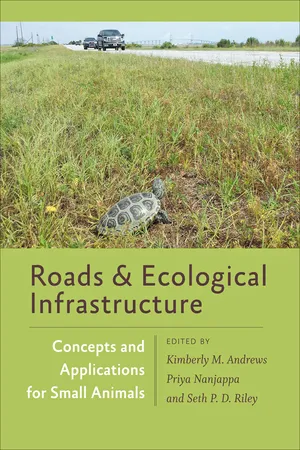
Roads and Ecological Infrastructure
Concepts and Applications for Small Animals
- English
- ePUB (mobile friendly)
- Available on iOS & Android
Roads and Ecological Infrastructure
Concepts and Applications for Small Animals
About this book
A practical guide that explains how we can design roads that are compatible with populations of small wildlife.
Few of us think twice about driving on roads. Yet the very presence of roads and the act of driving on them can impact the ecological infrastructure that supports an animal's daily life. What chance does a turtle have of successfully laying its eggs when it needs to traverse a busy highway? Is it realistic to expect small mammals to breed when an interstate thoroughfare subdivides their population? These are the sorts of challenges faced by small, often slow-moving, animals, challenges that road engineers and ecologists are trying to address.
For countless small species, vehicles traveling at high speeds are nothing less than missiles shooting across migration pathways. For too many animals, the danger can lead to the loss of populations, in part because they simply are not programmed to react to traffic. Salamanders faced with a two-lane road between the forest and their aquatic breeding site, for example, will typically cross that road regardless of the congestion. The result can be hundreds of flattened animals in a single night.
Roads and Ecological Infrastructure is the first book to focus on reducing conflict between roads and small animals. Highlighting habitat connections and the challenges and solutions from both transportation and ecological perspectives, the volume covers various themes, including animal behavior related to roads and design approaches to mitigate the negative effects of roads on wildlife. The chapter authors—from transportation experts to university researchers—each promote a goal of realistic problem solving. Conceptual and practical, this book will influence the next decade or more of road design in ecologically sensitive areas and should prevent countless unnecessary wildlife fatalities.
Published in association with The Wildlife Society.
Frequently asked questions
- Essential is ideal for learners and professionals who enjoy exploring a wide range of subjects. Access the Essential Library with 800,000+ trusted titles and best-sellers across business, personal growth, and the humanities. Includes unlimited reading time and Standard Read Aloud voice.
- Complete: Perfect for advanced learners and researchers needing full, unrestricted access. Unlock 1.4M+ books across hundreds of subjects, including academic and specialized titles. The Complete Plan also includes advanced features like Premium Read Aloud and Research Assistant.
Please note we cannot support devices running on iOS 13 and Android 7 or earlier. Learn more about using the app.
Information
Table of contents
- Cover Page
- Title Page
- Copyright Page
- Dedication
- Contents
- List of Contributors
- Foreword, by Lenore Fahrig
- Acknowledgments
- Introduction
- 1 A History of Small Animal Road Ecology
- 2 Natural History and Physiological Characteristics of Small Animals in Relation to Roads
- 3 Direct Effects of Roads on Small Animal Populations
- 4 Road Effects on Habitat Quality for Small Animals
- 5 Engaging the Public in the Transportation Planning Process
- 6 The Current Planning and Design Process
- 7 Sources of Funding
- Practical Example 1
- 8 Planning and Designing Mitigation of Road Effects on Small Animals
- 9 Mitigating Road Effects on Small Animals
- 10 Modifying Structures on Existing Roads to Enhance Wildlife Passage
- 11 Construction and Maintenance
- 12 Monitoring Road Effects and Mitigation Measures and Applying Adaptive Management
- Practical Example 2
- 13 The Road Ahead
- Index